Last updated October 2019: Prices and links have been updated to reflect current availability.
Editor’s Choice: Mountain Hardwear Super/DS StretchDown Hooded Jacket
We consider our list of the best down jackets of the year to be exhaustive, but throughout the year, we tested many more that you won’t see here. Down jackets have existed as functional outdoor protection for decades, and while the central concept that guides their design — ultralight warmth — hasn’t changed over the years, companies are still finding new ways to make them more functional than ever.
Mountain Hardwear is one of those companies. Instead of adhering to the iconic horizontal baffle design, it used a meandering pattern and a woven construction to disperse the down throughout the coat, thereby increasing durability and stretch while minimizing cold spots. The Super/DS StretchDown also uses a stretchier shell fabric that’s less shiny than traditional down coats, making it more approachable for those trying to avoid looking too “outdoorsy.” The sum of all these features is a down jacket with a vast range of applications. Mountain Hardwear may have built it for rock climbing, but the Super/DS StretchDown Hooded Jacket can function anywhere. Plus, with a price tag that’s less than $300, it’s also very affordable.
Weight: 17 ounces
Fill Material: Q.Shield responsibly-sourced down; 90% goose down, 10% goose feather
Fill Power: 800
Shell Material: Toray I-Tube (85% nylon, 15% elastane)
Waterproofing: DWR
Introduction
Down is warm enough that ducks and geese can swim in freezing water and light enough that they can fly. It’s those two qualities that also make it arguably the best form of insulation yet devised for outdoor apparel. Down’s warmth, light weight and ability to compress make it the perfect material for activities like skiing, mountaineering and backpacking (it’s also great for just cruising around the city, too). Advances in chemical treatments also mean that down jackets are more resistant to down’s mortal enemy, moisture, than ever before. From lifestyle wear to burly mountaineering layers, down jackets are lighter, tougher and more water resistant than ever. These 12 jackets are perfect for every activity, from walking your dog on frigid January mornings to conserving warmth and energy at Camp Four.
What to Know Before You Buy a Down Jacket
An Intro to Down
Down is found in layers underneath the rougher outer feathers of ducks and geese — it’s what keeps them warm while floating around all winter, so, naturally, it will keep us warm too. Despite that, moisture is the undoing of down, causing it to clump up and lose its heat-retaining qualities. It also should be noted that while large-scale efforts have been made by big brands such as Patagonia and The North Face, not all down is ethically sourced, and animal cruelty does happen.
Fill Powers Decoded
Down fill powers are numerical ratings that usually range anywhere from about 450 to 900. This number comes from a standardized test in which an ounce of down is compressed in a graduated cylinder and then measured for volume in cubic inches; that volume is the fill rating. An ounce of 900-fill down occupies more space (and thus traps more air and provides more warmth) than an ounce of 600-fill down. The two samples weigh the same, but one takes up more space and can trap more air, which means more warmth.
What this boils down to is the idea that a higher fill power means more warmth for less weight. It’s important to note that two jackets or sleeping bags may have different fill ratings while providing the same amount of warmth — the difference is that whichever has the higher rating will pack down to a smaller size because less material is needed to get the same amount of warmth. High down fill powers tend to come with a heftier price tag, so consider what you’re going to use a product for when getting into those loftier feathers.
The 12 Best Down Jackets of 2019
Best All-Round Jacket: The North Face Summit L3 Down Hoodie
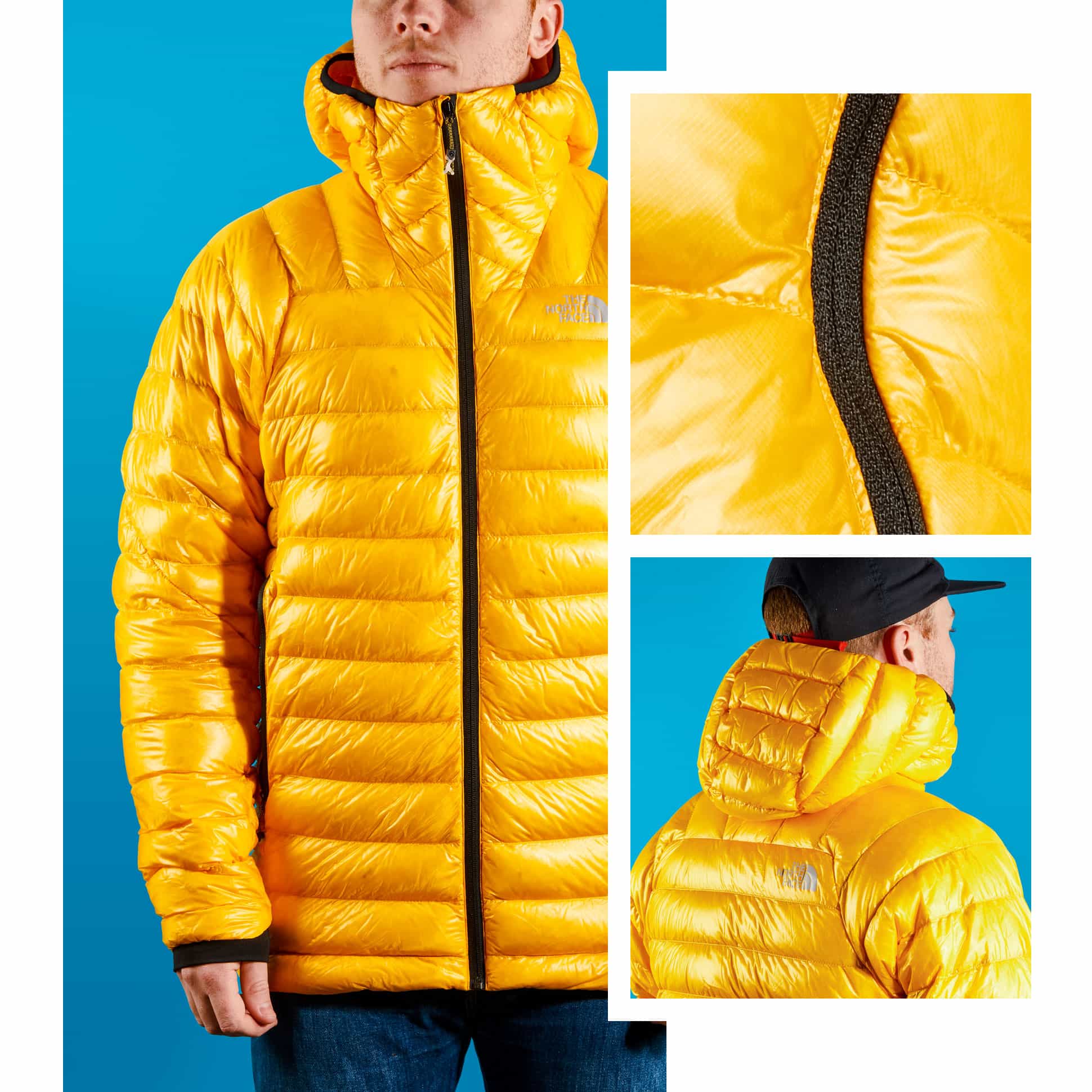
Summit Series represents the most technical apparel and equipment that The North Face can cook up. These are the tents that are used as Himalayan base camps, the one-piece suits that look as suitable for outer space as for high peaks. It’s not just marketing chatter either; The North Face outfits its ambassador athletes in this stuff so that they’re better equipped to explore the places in the world we might only see in the pages of National Geographic, and when it sent its team to Antarctica this summer, it kitted them out in the L3 Down Hoodie.
In an expedition kit, the L3 is more of a mid-layer, which means it’s perfect for the rest of us who tend to explore less extreme latitudes. It’s the classic down jacket, made thoughtfully in every way: it’s lightweight with 800-fill down and a ripstop exterior, includes two hand pockets, an adjustable hem and an adjustable hood. It has a much wider range of motion than we expected and is treated with a DWR finish. The best thing though? The cuffs, which are soft and stretchy and more comfortable than what the rest of the field uses.
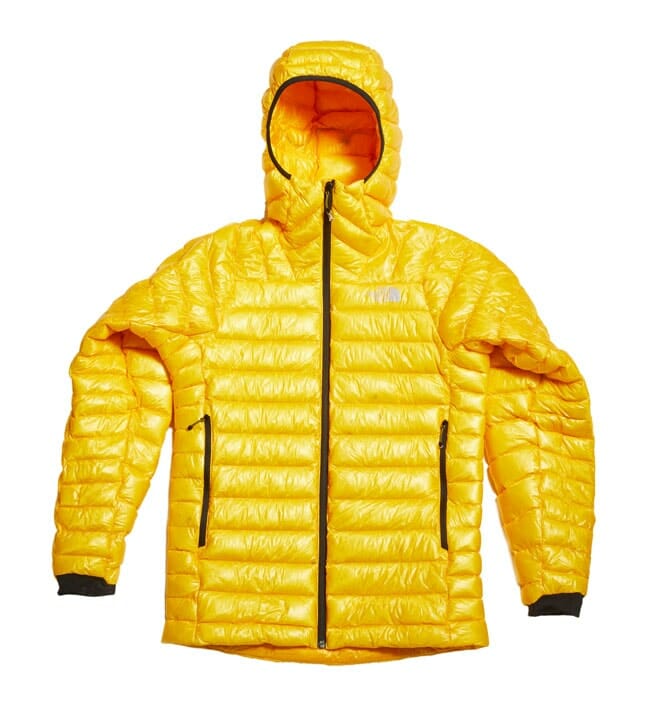
Weight: 13.4 ounces
Fill Material: responsibly-sourced goose down
Fill Power: 800
Shell Material: nylon
Waterproofing: DWR
Best Jacket for Active Outdoor Pursuits: Blackyak Bakosi
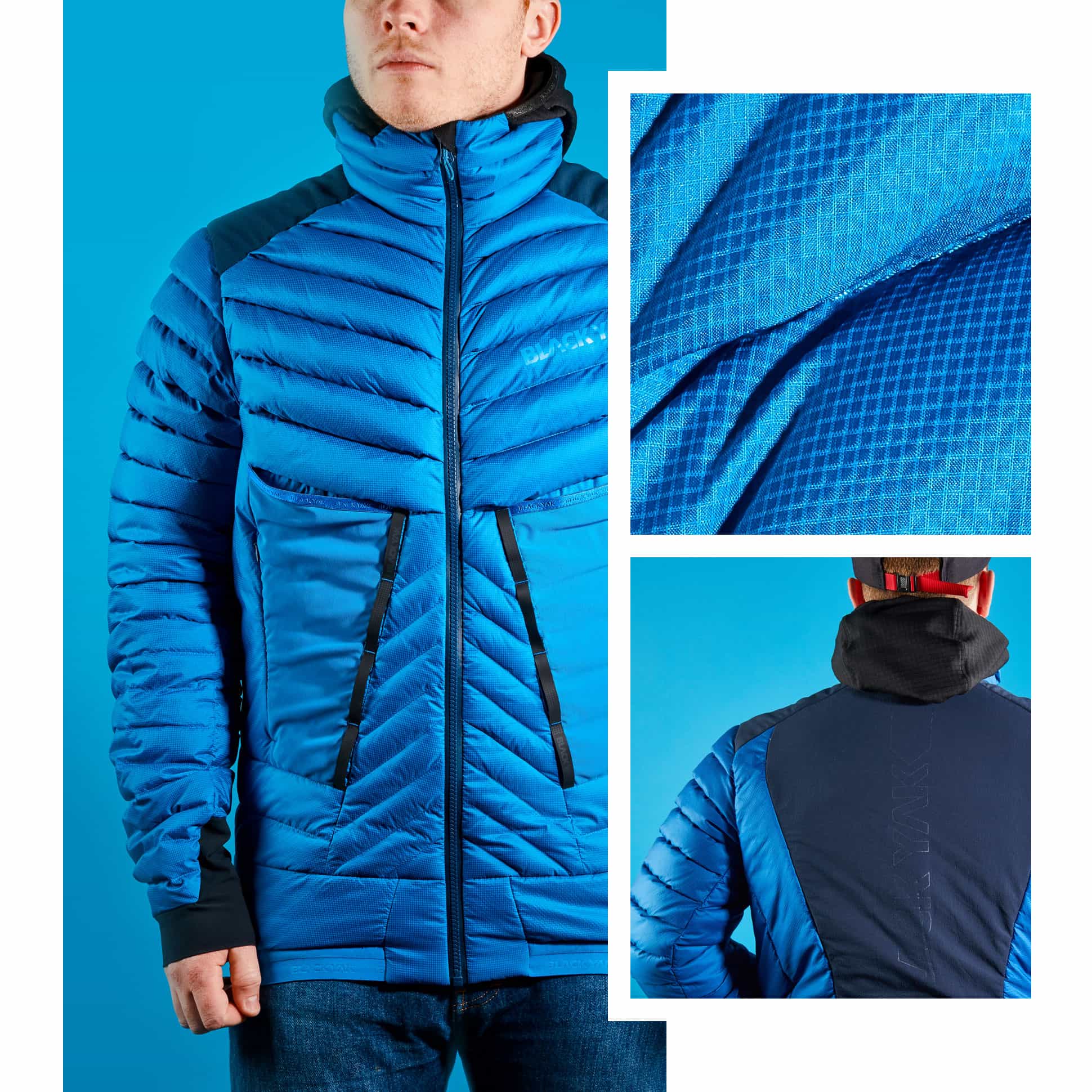
The Bakosi is far from the typical down jacket. Some of its unique features are obvious — like the two deep mesh pockets that are on its front or the lightweight grid fleece hood. They’re a departure from the “normal” image of what a down jacket looks like, but they have real-world application in mind. That hood, for instance, is more form-fitting than a down-filled one and doesn’t inhibit field of vision. It also fits under a helmet or stretches over a baseball cap.
But the Bakosi excels with features that are less visible — specifically, a body-mapped construction that combines both down and synthetic insulation as well as stretch paneling. The idea behind this is that the body retains and vents heat differently in different locations. For instance, the arms don’t need as much insulation, so Blackyak shrunk the baffles here and added less fill. Goose down is used on the upper section of the jacket to provide maximum warmth while the lower region is filled with synthetic Primaloft Gold, which is also water-resistant. The back is extra stretchy and filled with Polartec Alpha, another synthetic insulation that’s highly breathable — this helps with that sweaty back issue you might experience while climbing or hiking. It’s a complex construction (which contributes to its high price tag) but it’s also incredibly well thought-out, and more importantly, it works.
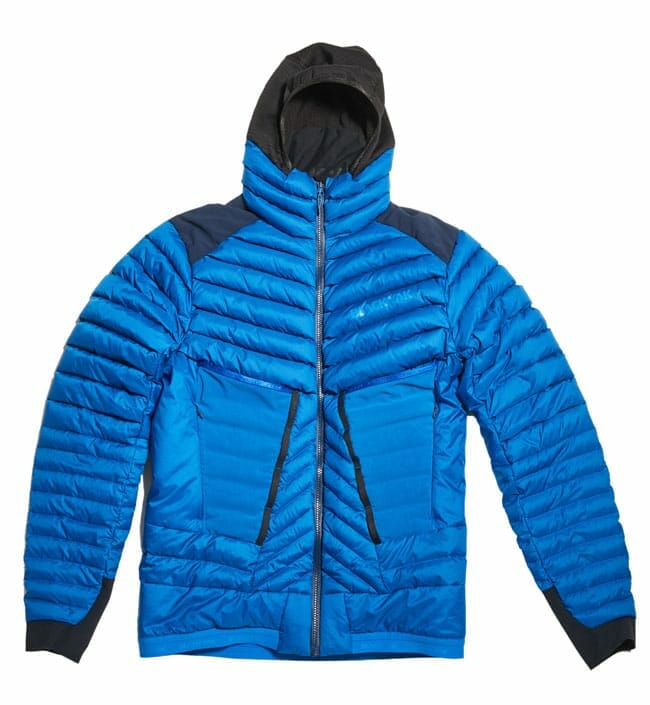
Weight: 21 ounces
Fill Material: traceable goose down, Primaloft Gold, Polartec Alpha
Fill Power: 750
Shell Material: Cordura ripstop nylon, Cordura 4-way stretch fabric, Polartec Power Grid fleece
Waterproofing: DWR
Best Jacket for Freedom of Movement: Mountain Hardwear Super/DS Stretchdown Hooded Jacket
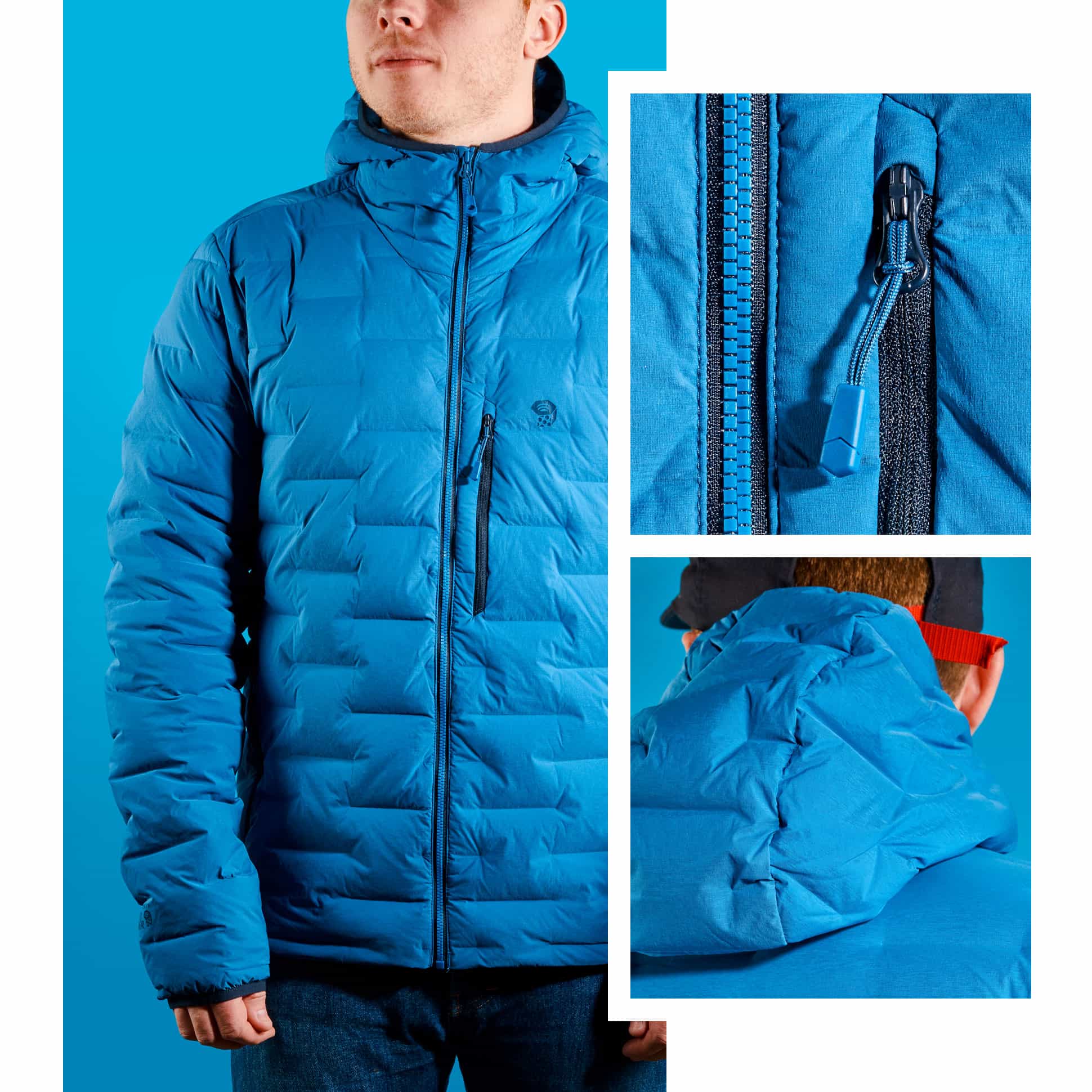
The first noticeable feature in Mountain Hardwear’s latest down jacket is that it’s done away with traditional baffles entirely. Instead of stitching, the Super/DS Stretchdown uses woven baffles to create the maze of channels that hold its 800-fill down insulation in place. The advantages of this are twofold; baffle stitching is a recurring culprit for durability issues, and the new weaves do exactly what they’re supposed to do — they stretch. I purposely tried to flex the jacket to its limits, Hulk-style, and never actually reached them. That alone makes the StretchDown a great option for active use. It also gives the jacket a unique visual appeal — the small woven segments create a natural crinkled look.
The outer shell material of the StretchDown is an equally stretchy fabric made exclusively for Mountain Hardwear from a blend of nylon and elastane that isn’t waterproof (like most of the jackets on this list) but does have a DWR treatment. The fabric also has a rougher, less plastic feel to it, which we found to be a welcome departure from what traditional ripstop texture. Two zippered hand pockets, an exterior zippered chest pocket with an internal headphone port and an inner mesh sleeve allow for ample opportunities for essential gear stashing and give this jacket a wide range of application, far beyond rock climbing.
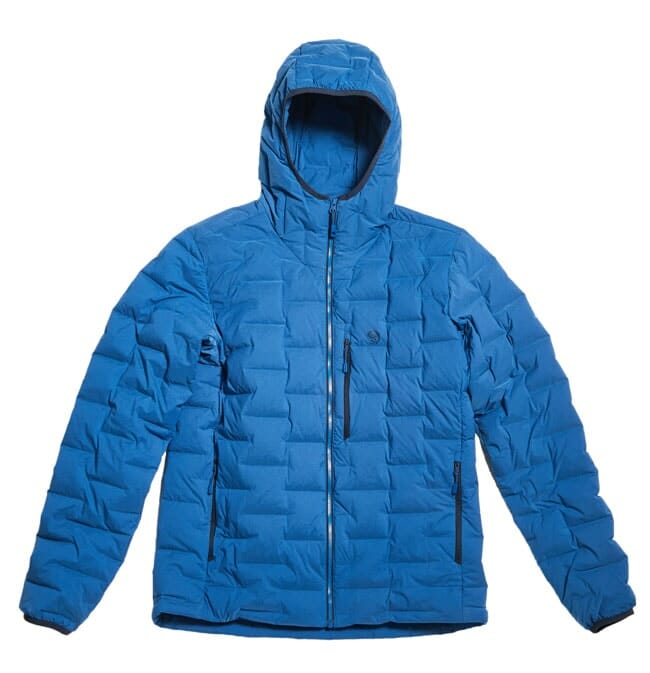
Weight: 17 ounces
Fill Material: Q.Shield responsibly-sourced down; 90% goose down, 10% goose feather
Fill Power: 800
Shell Material: Toray I-Tube (85% nylon, 15% elastane)
Waterproofing: DWR
Most Stylish Down Jacket: Foehn Robson Down Hoody
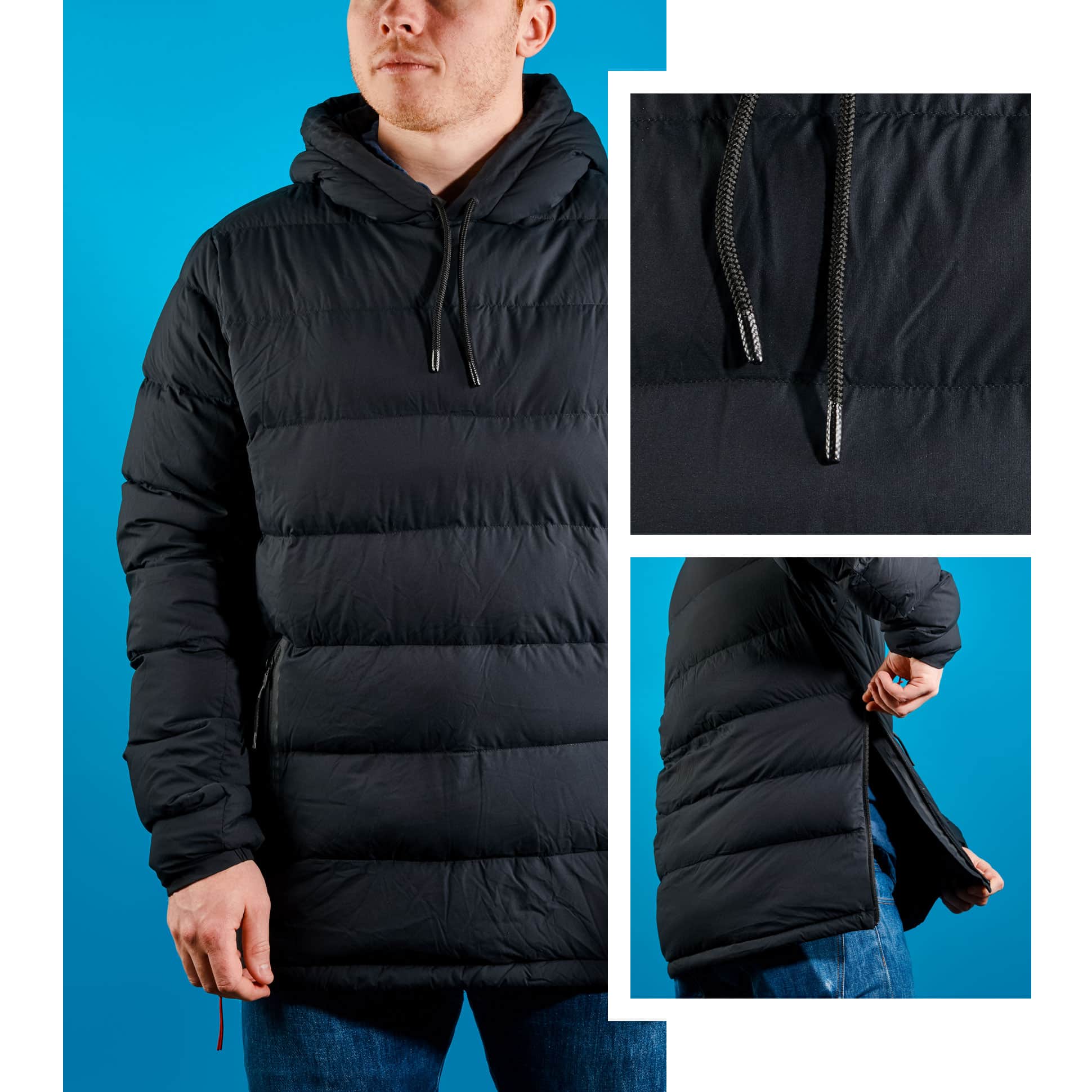
Familiarize yourself with Foehn. The small brand, which draws its name from the type of warm wind that can develop on the leeward side of mountain ranges, produces a small collection of apparel with rock climbing in mind while paying close attention to style — everything that the brand makes is suitable for city life too. Foehn’s most well-known piece is the Brise Pant, which raised more than $70,000 on Kickstarter, but its down jacket is equally-worthy of high praise.
Unlike many of the other jackets on this list, the Robson is a pullover. It doesn’t use the common quarter-zip construction either, favoring a zipper on the side to accommodate entry and exit instead. This keeps the jackets face — a matte, Japanese-made stretch fabric treated with DWR — plain, like a sweatshirt. It makes for a stylish profile that’s sure to draw compliments (and questions about who makes it). But the Robson isn’t all looks; it’s plenty warm with a substantial helping of 800-fill down and includes laser-cut underarm vents that aid breathability during high-output activities.
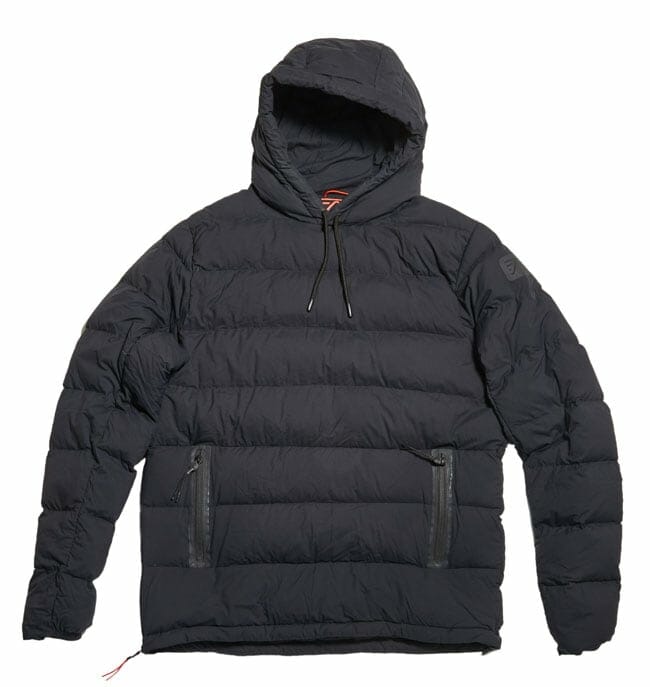
Fill Material: responsibly-sourced down
Fill Power: 800
Shell Material: Nylon
Waterproofing: DWR
Best Expedition Jacket: Jöttnar Fjörm
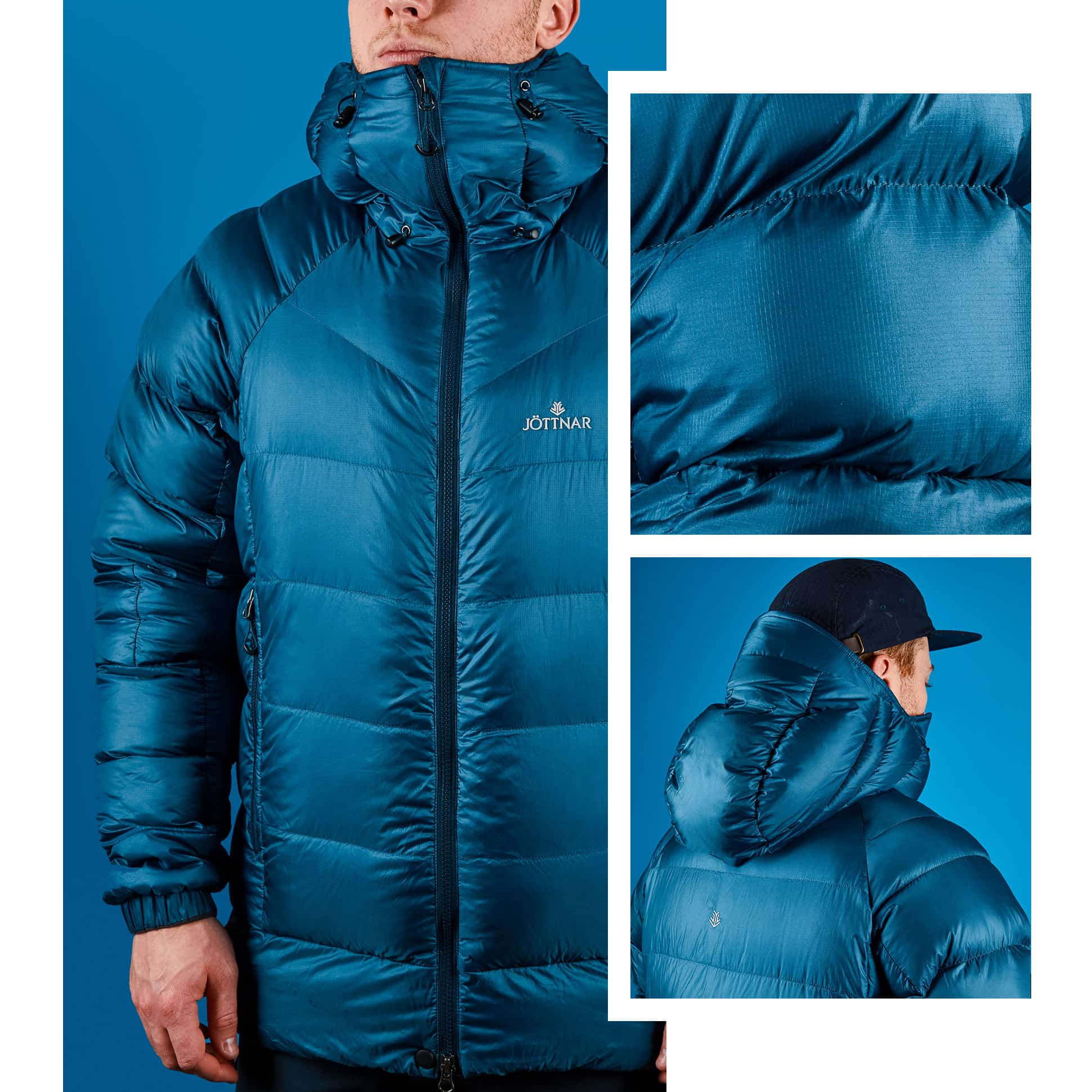
Jöttnar’s tagline is “Conquer Giants,” and that’s exactly what this expedition-class down jacket was built to do. The Fjörm is big, puffy, and most of all, warm. It’s filled with just under ten ounces of DownTek’s responsibly-sourced, water-resistant, 850-fill goose down — that’s a lot of warmth, but the jacket is still incredibly lightweight and compressible (it packs down into what seems like an impossibly-small stuff sack). That much warmth may be overkill for shoulder season use, but the jacket still breathes well enough to be worn in temperatures just above freezing and is certainly suited to go far below that mark.
Despite the Fjörm’s size, it doesn’t feel bulky, as some expedition jackets tend to. It’s also incredibly comfortable, and Jöttnar improved the cuffs (small yet key points of jacket-on-skin abrasion) with the addition of a fleece lining. A drawcord waist, extra-large internal gear pocket, helmet compatible hood, and two-way zipper give the Fjörm serious (and practical) mountain chops. But while this jacket may be built to equip high elevation adventures, its undeniable warmth and comfort make it suitable for wear in cities that see their fair share of frigid temperatures (like New York, for example).
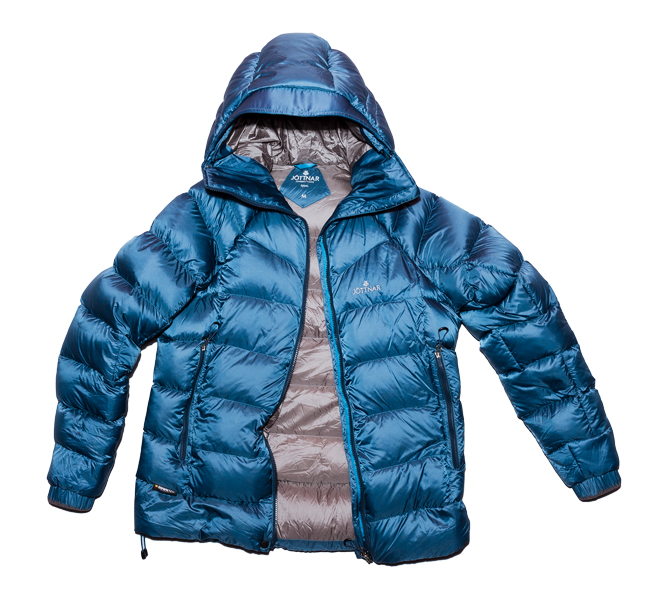
Weight: 9.7 ounces
Fill Material: DownTek hydrophobic goose down, synthetic fill in cuffs and neck
Fill Power: 850
Shell Material: nylon
Waterproofing: DWR
Best Down Jacket for Cities: Norrona Lyngen
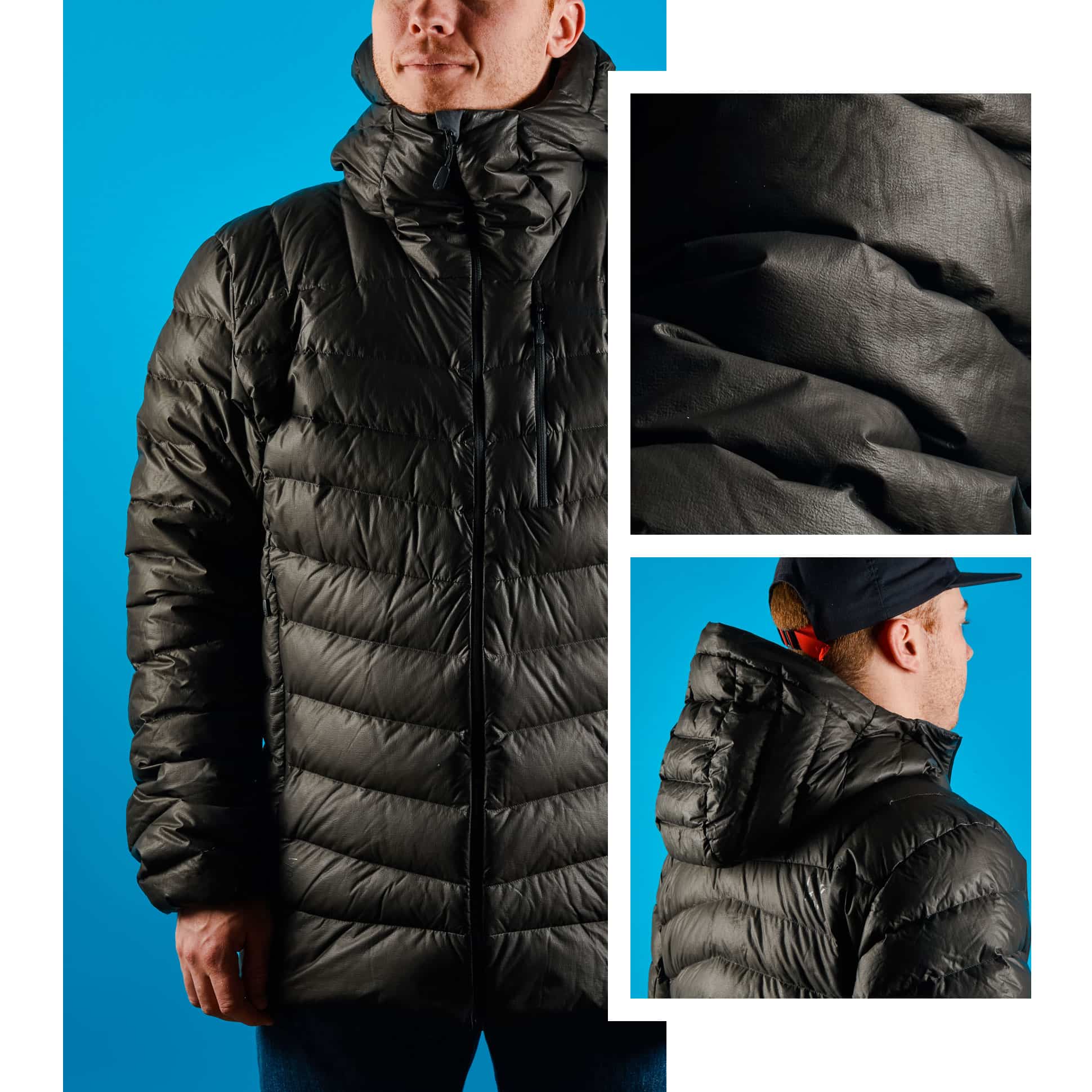
Not everybody is into the look of technical winter gear. The materials that make jackets warm and waterproof are often shiny or brightly-colored and covered in pockets and zippers, making wearers look like they’re headed to the mountains when they might just be commuting to the office. Gore-Tex launched its Infinium with remedying this stigma in mind. With Infinium, lifestyle drives performance, and technical fabrics might not look like technical fabrics, even though they’re still highly weather-proof and breathable.
It’s true for Norrona’s Lyngen down jacket. Its outer shell is water-repellant and fully windproof, but unlike many of the other options here, it doesn’t have the characteristic sheen of ripstop nylon. Instead, it looks and feels more like a thin layer of leather. But style isn’t the Lyngen’s only play; that same material is incredibly breathable (Norrona built this jacket with ski touring in mind) and it’s filled with a hearty load of 850-fill, responsibly-sourced down. It’s very warm as a result — warm enough to wear as an outer layer in Northern Hemisphere towns during the dead of winter.

Weight: 17 ounces
Fill Material: responsibly-sourced down
Fill Power: 850
Shell Material: Gore-Tex Infinium
Waterproofing: Gore-Tex Infinium (water-repellant)
Best Budget Pick: REI Magma 850 Down Hoodie

If you’re looking for the classic down jacket — the kind with pockets for your hands and another on the chest, a hood and not much else, look to REI’s Magma 850. That’s not to reduce the Magma’s value (we wouldn’t include it on this list if it lacked in any way) but to highlight the fact that this jacket is great because it’s simple. At just under 14 ounces, it’s lightweight and made to be durable with abrasion-resistant Pertex Diamond Fuse ripstop nylon fabric. Inside is enough 850-fill goose down to provide plenty of warmth as a mid layer or an outer layer. It’s everything the quintessential down jacket needs to be, and at $219 it’s also a steal. Editor’s note: This jacket is no longer available, but its successor, the Magma 850 Down Hoodie 2.0 boasts equivalent features, different colors and the same amazing price.

Weight: 14 ounces
Fill Material: responsibly-sourced goose down
Fill Power: 850
Shell Material: Pertex Diamond Fuse ripstop nylon
Waterproofing: DWR
Most Innovative Down Jacket: Mammut Broad Peak Pro

Of all the companies to eliminate stitching, Mammut does it in the way that maintains the look and feel of the classic down jacket. The problem with stitching is that it creates gaps in the insulation where cold spots can occur, pierces the shell fabric and has a tendency to fail after lots of wear (and sometimes before). To get rid of it is to make a jacket warmer, lighter and more durable. Mammut’s Broad Peak uses a weave pattern that the company calls Pocket Weave Technology — the exterior and interior fabric are woven in such a way that they create the baffles without the need for additional fabrics or liners. Cold spots are minimized, and weather protection (and warmth) increases.
That construction is enough on its own to make the Broad Peak Pro an excellent down jacket, but it excels in other ways too. The jacket has two large hand pockets that are situated so that they can be accessed while wearing a harness, but there are also two drop-in sleeve pockets on the inside for other small items. It’s stuffed with 850-fill goose down to provide serious warmth without too much bulk. One thing to note is that Mammut, which is based in Switzerland, built the Broad Peak Pro with a slim Euro profile that might not be suitable for those looking for lots of jacket coverage, but is ideal for use as a mid layer.

Weight: 13 ounces
Fill Material: goose down
Fill Power: 850
Shell Material: Pertex Quantum polyamide
Waterproofing: water-repellent
Best Ultralight Jacket: Montbell Plasma 1000

If you aren’t familiar with Montbell, you should be. They are one of my favorite ultralight brands (I own two of the brand’s sleeping bags). After testing the Plasma 1000, I was not disappointed. At first, the aesthetics of the Plasma 1000 didn’t sell me. The MVDS (Mojave Desert) colorway felt a bit too spaceman for my tastes, but it quickly grew on me. As soon as I picked up the jacket I was shocked — I’ve felt lightweight rain jackets that are heavier. When you toss it up in the air and let it float down, hyperbole aside, it literally mimics a feather. Despite its lean stature, the Plasma is toasty warm and packs down into a tiny stuff sack that fits in its pocket. I took the jacket on a shoulder season camping trip, and I’m glad I did. It took up virtually zero space in my pack and was warm enough to extend a sunset hike into the dark. In the ultimate test, I got a bit too close to the campfire on more than one occasion. Shockingly, none of the flying embers managed to put a hole in the Ballistic Airlight rip-stop nylon shell. — AJ Powell

Weight: 4.8 ounces
Fill Material: Power EX Down
Fill Power: 1000
Shell Material: 7-denier Ballistic Airlight rip-stop nylon
Waterproofing: DWR
Best Jacket for Inclement Weather: Eddie Bauer BC EverTherm

Last year, Eddie Bauer released Thindown, an innovative down insulation that arranges feathers in fabric-like sheets rather than loose clusters. Thindown, which debuted in the EverTherm jacket, eliminates the need for down jackets to use baffles and in turn, disposes of stitching and the cold spots it creates. Long story short, the new fluff helped Eddie Bauer make a down jacket that was lighter and warmer. Eddie Bauer continued the development of Thindown with a new down jacket called the BC EverTherm. The jacket’s evolution was guided by Seth Waterfall, a member of Eddie Bauer’s First Ascent athlete development team, who desired a waterproof, down-filled hardshell jacket. Thindown helped make it possible; it’s lighter than traditional down, and its sheets are treated with DWR so that they won’t clump when damp.
The BC EverTherm was designed with the high-alpine environments of the Cascades and Mt. Rainier in mind, but its functions apply wherever winter weather may vary unpredictably between snow and rain. Like, for instance, New York City, where we routinely put it to use during the occasional downpour. The original EverTherm was and still is excellent (we featured it on this list last year), but the BC EverTherm really excels as an all-rounder for rough winter weather.

Weight: 19.2 ounces
Fill Material: Thindown
Fill Power: n/a
Shell Material: nylon
Waterproofing: 20/20 waterproof/breathable rating, Eddie Bauer Stormrepel Super DWR
Best Overbuilt Down Jacket: Best Made Co. 3L Down Parka
Best Made Co.’s 3L Down Parka isn’t as lightweight as all of the other jackets on this list, and it won’t pack down into its own pocket, but it is seriously winter-proof. The parka is made to be heavy-duty, with a waterproof cotton-nylon blended shell, a ripstop lining and 850-fill down inside. It’s longer than the other jackets here too — the hem drops slightly below mid-thigh — but despite all that, it doesn’t really feel heavy or bulky (and it’s immediately warm).
Inspired partially by standard-issue jackets worn by the Marine Corps in the 1940s, the 3L Down Parka comes packed with lots of features: there are two hand warmer pockets and two button flap pockets on its exterior as well as a chest pocket and two drop-in sleeves on the interior. There’s also a cinch adjustment at the waist, which is more or less the jacket’s midpoint, in addition to another at the hem, and stretchy cuff liners prevent weather from entering the coat’s sleeves. Best Made Co. also outfitted the parka with a two-way zipper, which comes in handy should you need to access your pants pockets without completely opening up the jacket. At over $1,000, the 3L Down Parka doesn’t make any arguments for affordability, but if you’re looking for the biggest and warmest outer layer available, this is it.

Weight: n/a
Fill Material: goose down
Fill Power: 850
Shell Material: 70% cotton and 30% nylon
Waterproofing: DWR
Best Jacket for Bikepacking: Rapha Explore Down Jacket

Rapha is well known for its classically clean cycling apparel that fits and performs well on two wheels. You’ve likely seen the brand’s iconic bright pink accents on products like socks, jackets and base layers. This past year, Rapha experimented with luggage, with the same minimalist, upscale take. Next up, they’re turning their focus to the growing segment of bikepacking. To cater to this trend, Rapha has developed a unique sleeping-bag-and-down-jacket combo that is built to be used in tandem, but is sold separately. The jacket features a relaxed fit — slightly different than the slim cut for which the brand is typically known. It features a removable hood, and is built to be used with the brand’s Explore Down Sleeping Bag.
This isn’t Rapha’s first bikepacking product, but the brand decided it was time to start thinking about the category in a meaningful way. “We’ve spent years developing our new Explore range,” Alex Valdman, creative director at Rapha, says of the collection that includes cargo bib shorts, technical tees and polos. “We are continuing to build it out with functional must-have items for anyone who is planning an adventure.”

Weight: 230 grams (size medium)
Fill Material: Down
Fill Power: 850
Shell Material: Nylon
Waterproofing: DWR coating
How To Wash Your Down Jacket
Most people take their down jacket for granted, expecting it to perform the same year after year without any maintenance. Over time though, down becomes compacted and dirty, which inhibits its loft and makes the jacket less warm. To clean your jacket, revitalize its warmth and get it ready for all your adventures, follow our simple guide.
Put your jacket into a washing machine without an agitator. It is easiest to do this at a laundromat, but if your home washer is of the large, front-loading variety, feel free to toss it in there. If you use a washing machine with an agitator, you run the risk of tearing open your jacket or clumping the down in large balls inside — so avoid agitators at all costs.
Wash with Nikwax Down Wash. Though there are other good down washes out there (namely Granger’s), we recommend using Nikwax’s Down Wash. Add the Down Wash directly into the washing machine, using about three ounces. Follow the directions on the care label of your jacket for specific temperature and cycle settings.
Switch your jacket to the dryer and add tennis balls. Move your jacket over to the dryer, but before you turn it on, add in a package of new tennis balls. As the drier spins, the tennis balls will bounce around inside the drum, breaking up any clumps of down and helping dry the jacket completely. This also helps to restore the loft in the down feathers. As for dryer settings, low heat for a long period of time is the name of the game.
Pause the dryer and manually break up any clumps. Every twenty minutes or so, pause the dryer and manually work out larger clumps of down. While the tennis balls work well to help break up clumps, you’ll need to put some extra effort in to break them up completely.
Tumble dry until the jacket is completely dry. Dry the jacket until it is dry the entire way through. Not only does moist down function terribly as an insulator, it’s also prone to mold, which will lead to a stinky jacket.
The Gear You Need
Nikwax Down Wash $11
Tennis Balls $10




